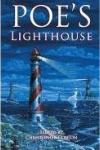Poe’s Lighthouse
Christopher Conlon, editor
Wicker Park Press
Trade Paper, 277 pages, $18.95
Review by Sheila M. Merritt
A fragment of a work, an unfinished story, composed by one of the most famous horror writers in the world. How irresistible is this to writers in the same genre, who are offered an opportunity to expound and explore the unresolved possibilities? Poe’s Lighthouse is a collection of tales that play with Edgar Allan’s bit of narrative, using it as a springboard for their stories. Christopher Conlon’s anthology addresses the literary remnant in ways that are quite specific to the authors assembled. Some have chosen to use the abbreviated yarn as a direct/linear follow-up. Others take the characters and employ them in treatments that reflect Poe’s mindset or environment. As a whole, the book is highly satisfying. There is a lot to choose from here, and some of it cuts close to the heart, like the swinging torture device in “The Pit and the Pendulum.”
There are emotionally engaging yarns that deal with distinctive forms of hauntings. In “Last Writes” by Scott Nicholson, for example, a ghost expresses her reign over the domain; dismissing the keeper’s guardian status: “He imagines himself a lighthouse keeper, yet he keeps nothing. He comes and goes, like the others. And still I shall remain. I am the real keeper here.” And a grim keeper, she is. An encounter with Poe proved life-altering, and the nice reveal at the tale’s end stresses the high price of literal and literary immortality. With fine attention to detail, Nicholson constructs a memorable spectre and an intriguing yarn.
In Gary A. Braunbeck’s “Fisherman’s Delight,” parents are haunted by the memory of their son as he was prior to a devastating accident. The youth is rendered severely mentally impaired by the calamity. When new writing is found in his spiral notepad, the mother and father don’t know what to make of it. The script is vastly different from the previous handwriting, and the language and content seems to be of another time; another person. Braunbeck approaches the fragment of Poe’s tale in an interesting manner while delivering a touching tale of communication and communion.
Cleverness abounds in this compilation of short stories. There is a lot of ingenuity in terms of integrating the required theme. One of the standouts in terms of inventiveness is George Clayton Johnson’s “A Literary Forgery.” Not only is Poe himself represented; his creation Dupin is a character in the narrative, as well. Allusions to various works by Poe are sprinkled throughout, and the ending is crackerjack.
Point of view is toyed with in Earl Hamner’s “A Passion for Solitude,” and to say too much about it would require a spoiler alert. Suffice to relate that the dual narrators convey very unique takes on what transpires in the environs of the lighthouse.
“Deep Into the Darkness Peering” by Elizabeth Engstrom is extremely commendable on many levels. Not only does it excel in dexterous application of the story fragment, it also eloquently gets inside the tortured soul of Poe: “The brandy was his muse as well his reason to live. How he hated it. How he loved it. He was imprisoned within that brown glass, and the resulting vision of his world was warped and dark.” Poe’s alcohol-spurred anguish is depicted as the source for his composing “The Lighthouse.” With brilliant use of metaphor, Engstrom employs the image of being trapped in a bottle of brandy; and likening it to the claustrophobic solitude of dwelling in a lighthouse. Other superb metaphors also combine to illustrate a theoretical merging of Poe’s world with his last known work.
Poe’s Lighthouse contains 23 tales that are proficient and entertaining. Originally published in hardcover by Cemetery Dance Publications in 2006, this trade paper reprint is a treat for Poe enthusiasts, in particular. And for horror fans, in general.









